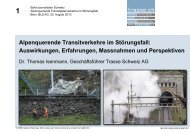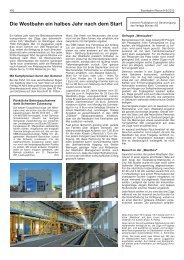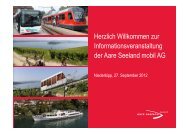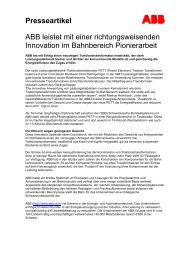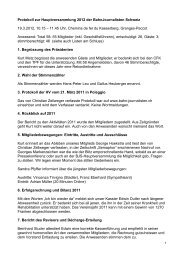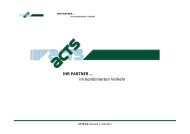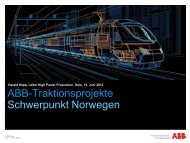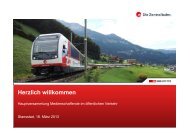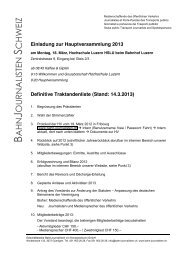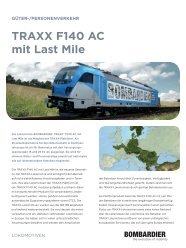Swiss oper short-h - bahn-journalisten.ch
Swiss oper short-h - bahn-journalisten.ch
Swiss oper short-h - bahn-journalisten.ch
- No tags were found...
You also want an ePaper? Increase the reach of your titles
YUMPU automatically turns print PDFs into web optimized ePapers that Google loves.
ators optimise<br />
aul railfreight<br />
covering about 200,000km a year, and<br />
completing a round trip within 24 hours.<br />
The philosophy is to keep the<br />
collection and delivery by road at either<br />
end of the rail trunk haul as <strong>short</strong> as<br />
possible. Trains run to fixed s<strong>ch</strong>edules<br />
at up to 120km/h, carrying up to 26<br />
containers ea<strong>ch</strong>. “This is not a lot, but<br />
we want to have <strong>short</strong>er trains for the<br />
sake of speed,” Mr Philipp Wegmüller,<br />
CEO of RailCare explains.<br />
Huge <strong>ch</strong>anges are in the pipeline,<br />
he says, with both new hubs and new<br />
services: “Our objective is only to have<br />
horizontal handling, including 40ft<br />
containers, and to automate all stages of<br />
handling as far as possible.” The latest<br />
innovation, introduced this year, was to<br />
equip the first of 60 refrigerated swapbodies<br />
with a GPS telematics system.<br />
One of RailCare’s clients is Heineken.<br />
The Heineken train, whi<strong>ch</strong> travels the<br />
length of the country between Domat<br />
and Daillens, uses an innovative new<br />
horizontal loading te<strong>ch</strong>nique dubbed<br />
ContainerMover 3000, designed by<br />
Innovatrain. “We wanted to develop a<br />
system that would cope with a standard<br />
20ft container as well as swap-bodies<br />
without any adaptation,” says Mr Pieter<br />
van den Bold, managing director of<br />
Innovatrain. The system comprises a<br />
“wagon adaptor” mounted on the lorry;<br />
it is hydraulically <strong>oper</strong>ated with<br />
electronic controls, and can transfer a<br />
unit weighing up to 22 tonnes between<br />
lorry and wagon within 3 minutes, even<br />
in extreme winter conditions. All it<br />
requires is a 3m wide stret<strong>ch</strong> of asphalt<br />
beside the railway.<br />
“We built the prototype in May 2011,<br />
and delivered the first 10 units to<br />
RailCare in November,” reports van den<br />
Bold. The system is attracting attention<br />
elsewhere too. “DB S<strong>ch</strong>enker selected<br />
two horizontal handling methods,<br />
including ours, and we demonstrated<br />
it to Volkswagen who were very<br />
impressed,” he says.<br />
“It’s very new; we’ve only had it on<br />
the market since the beginning of this<br />
year, and it’s important to prove it<br />
works well. But the first 10 units have<br />
already done eight months’ hard work<br />
for RailCare, so we’re making progress.”<br />
<strong>Swiss</strong> Federal Railways (SBB) set up<br />
its own subsidiary company called<br />
Cargo Domizil in 1981 specialising in<br />
intermodal overnight inland freight. It<br />
was taken over in 1996 by a consortium<br />
of three haulage companies - Planzer,<br />
Camion and Galliker - and, following<br />
restructuring and a new location<br />
concept, broke even for the first time<br />
two years later. Now it carries 10,000<br />
consignments a night between 10<br />
locations in Switzerland, with 60%<br />
by rail and 40% by road.<br />
Using Planzer’s logistics expertise,<br />
freight flows can be combined, transit<br />
times reduced, reliability improved,<br />
emissions cut, and full advantage taken<br />
of the <strong>Swiss</strong> ban on trucks driving at<br />
night. “Nobody at SBB Cargo has any<br />
logistics know-how,” explains<br />
Mr Fridolin Landolt, a Planzer board<br />
member. “But there is still room for<br />
improvement in the availability of rail<br />
infrastructure and locations for hubs,<br />
whi<strong>ch</strong> have to be in the right place.”<br />
From this year, Planzer is also<br />
masterminding the supply of goods to<br />
Zermatt, where road access is restricted.<br />
The Matterhorn-Gotthard Railway<br />
(MGB) was managing this <strong>oper</strong>ation<br />
itself, but realised it was more efficient<br />
to concentrate on running a railway and<br />
to commission an expert partner to look<br />
after the logistics side. Planzer formed a<br />
new company, Alpin Cargo, to deal<br />
with everything except carriage by rail<br />
under an initial five-year contract. “We<br />
have two terminals, one in Visp and one<br />
in Zermatt, and run 38 freight trains a<br />
week,” says Mr Jean-Pierre Wettstein,<br />
another Planzer board member. “From<br />
IRJ October 2012 25<br />
Photo: David Gubler



